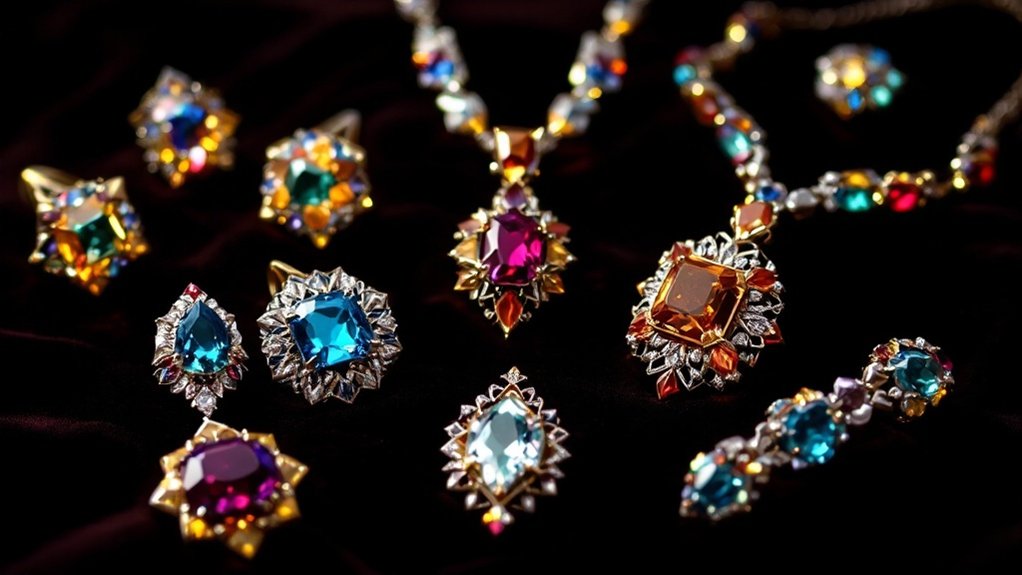Iconic Jewellery Designers of the 20th Century: Gérard Sandoz: Art Deco Geometry in Jewels
When Gérard Sandoz displayed his Art Deco Geometric Brooch at the 1925 Exposition Internationale in Paris, he captivated onlookers with his acceptance of modernity and precision. As a jewellery designer thriving in the Machine Age, Sandoz translated the Jazz Era’s dynamic rhythm into bold forms and contrasting materials, redefining luxury ornamentation. His training and influences are as intriguing as the pieces he crafted. But what was it about his approach that carved a distinct niche in the world of jewellery design, and how do his creations continue to resonate with today’s collectors and connoisseurs? Let’s examine. In a world where traditional craftsmanship and contemporary design intersect, Gérard Sandoz’s legacy remains a source of inspiration for jewellery artists and enthusiasts. His collaboration with Van Cleef & Arpels history reflects his innovative spirit and enduring impact on the evolution of luxury ornamentation. By examining his life and work, we can unravel the timeless allure of his creations and their enduring relevance in the world of fashion and design.
Article Contents
Biographical Insights
Born in Paris in 1902, Gérard Sandoz was immersed in the world of jewellery and art from an early stage. His surroundings were rich with influences that shaped his future, entwining his destiny with the arts.
Sandoz’s father, Gustave-Roger, a craftsman of note, and his uncle, Paul Follot, a celebrated designer, infused his youth with lessons in elegance and precision. This nurturing environment never constrained him, instead, it granted him wings to explore.
Under his father’s adept guidance, he trained assiduously in the workshop, where he mastered the intricate crafts of jewellery and silversmithing. This early training was integral, as it laid the foundation for his path, allowing him to blend traditional craftsmanship with avant-garde tendencies. His mother, although not directly influencing his trade, played a crucial role in his upbringing by fostering an environment where creativity flourished.
These elements coalesced, propelling his unique voice within the Modern jewellery movement. At the height of the Art Deco period, Sandoz’s work highlighted the complex, layered shapes that became iconic in the design masterpiece characteristics of the era.
Family influences didn’t dictate his direction but rather provided a platform from which he could launch into his creative domain. Sandoz dared to intersect conventional methods with imaginative artistry, probing boundaries others might bypass.
His early exposure to both classical techniques and modern artistic expressions encouraged an ethos of liberation, urging Sandoz to embody his vision without restraint.
Distinctive Design Style
Gérard Sandoz distinguished himself in the 20th century with his distinctive design style in jewellery, which boldly combined geometric precision and pioneering material use. As a master of Art Deco geometry, Sandoz crafted pieces that incorporated geometric shapes with meticulous precision, reflecting the technological advancements of the 1920s.
His work employed a diverse range of materials, blending precious and semi-precious stones like black onyx, rock crystal, and diamonds into striking geometric compositions. Influenced by the work of prominent jewellers like Jean Fouquet, Paul Brandt, and Raymond Templier, Sandoz was part of the esteemed school of artist-jewellers, known for their emphasis on bold design motifs. Sandoz, a visionary jeweller of the 1920s, was renowned for integrating mechanistic designs in his work, which mirrored the era’s technological strides.
Material innovation was at the heart of Sandoz’s creations. He used platinum and 18-carat yellow gold for intricate metalwork, adding layers and depth, while enamel and eggshell brought texture and colour. His innovative settings, such as using pavé and millegrain techniques, accentuated his geometric motifs, thereby subverting conventional jewellery concepts. Inspired by cubist geometry and modernist ideals, Sandoz’s designs emphasised symmetry and bold colour combinations, particularly striking in black and white.
His unexpected reversal of traditional elements, prioritising metals over stones, added to his avant-garde approach. Gérard Sandoz remains a celebrated figure in the Art Deco movement, his work enduring as an evidence to both geometric precision and material innovation.
Celebrated Works
Among the celebrated works of Gérard Sandoz, the Art Deco Geometric Brooch stands out as a masterpiece of design ingenuity. With its composition of layered geometric shapes, including a peaked polished gold rectangle and onyx rectangles, Sandoz’s creation captures the essence of the Art Deco movement.
Various pieces from renowned designers, including those with rare and unusual pieces, were also part of the jewellery offerings. The piece’s striking design, influenced by Cubist geometry and the Machine period, heralds a departure from traditional jewellery norms of the Edwardian time. Sandoz, born into a family of clockmakers and jewellers, was destined to leave a profound impact on the jewellery world with his innovative designs.
The use of diamonds as a backdrop, reversed to highlight polished gold as the focal point, revolutionised fine jewellery aesthetics. Frosted rock crystal triangles layered over a diamond pave triangle add a sophisticated touch, all mounted in 18-carat yellow gold and platinum. This brooch, measuring a compact 2 × 2 × 3/4 inches, exemplifies Sandoz’s skill in melding historical context with cultural impact.
His integration of Oriental forms and enamelling techniques further enriched his work, setting a bold precedent in jewellery design. By signing each piece, Sandoz offered authenticity, reflecting his craftsmanship.
Despite a limited period of creation from 1920 to 1934, Sandoz’s works remain highly sought after, emblematic of freedom and innovation in art.
Impact and Legacy
The legacy of Gérard Sandoz in the domain of 20th-century jewellery design is both enduring and transformative. Sandoz’s innovative use of materials and forms expanded the limits of Art Deco jewellery, exhibiting a unique artistic impact. By integrating contrasting materials such as gold, silver, and lacquer, Sandoz engineered complex, layered designs that echoed the geometric precision of Cubist art. His bold use of colour, informed by his colour blindness, catalysed a shift in stylistic norms, placing polished gold at the forefront rather than as a mere backdrop.
Notably, Sandoz reversed the traditional material hierarchy in jewellery, often using diamonds as the background and gold as the central element in his innovative compositions. Culturally, Sandoz captured the zeitgeist of the Machine Era and Jazz Era through his jewellery. His works symbolised a break from tradition, reflecting the modern world’s mechanical aesthetic. By drawing inspiration from machinery and technology, Sandoz paved the way for subsequent designers to adopt innovation and modernity, reshaping jewellery design language entirely.
Sandoz’s impact extended beyond mere style; it influenced the very ethos of jewels as art rather than mere adornment. A prime example of this is his geometric lacquer composition integrated in double cuff links, such as the piece circa 1929 from France, which showcases his daring use of colour and technique. This visionary’s brief yet potent jewellery career attests to an impressive cultural impact, aligning him with the avant-garde of his time and enshrining his masterpieces within the annals of jewellery history.
Collectability and Market Value
Celebrated for his enduring influence on jewellery design, Gérard Sandoz‘s work has garnered significant interest among collectors and investors alike. His creations’, time spent under the spotlight of market trends, reveals a persistent upward trajectory. This allure stems from Sandoz’s tenure with the Art Deco movement, immortalised at the 1925 Exposition Internationale des Arts Décoratifs et Industriels Modernes in Paris.
Not only do his geometric masterpieces—crafted from coral, onyx, and eggshell—hold historical significance, but their rarity also incites fervent demand, their brief production ensuring scarcity. Gérard’s artistic style, characterised by simple forms and geometric lines, reflected an avoidance of superfluous frills and a strong embrace of contrasting colours like coral and onyx, which only added to their distinctiveness. His pieces produced by Maison Sandoz, though few due to the firm’s closure in 1931, remain coveted in today’s market due to limited production.
Collectors prize the unique designs and exceptional craftsmanship, while investors see a lucrative opportunity in their investment potential. Each signed piece, backed by provenance, adds a compelling layer to their allure, assured of appreciating market value over time. Auction floors often witness fervour as Sandoz’s pendants fetch astounding amounts, commanding attention and pounds alike.
The increasing value acknowledges the exquisite aesthetic and demonstrates a timeless allure that surpasses current trends. Yet, with replicas sometimes muddying waters, expert valuations become indispensable, guiding informed investments. Gérard Sandoz’s creations offer adornment and an enduring legacy of artful innovation.




